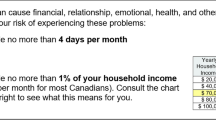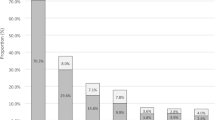Abstract
Gambling is emerging as a significant health issue. Problem gambling does not develop instantaneously and is often the result of risky consumption patterns over a period of time. Early intervention strategies depend on a detailed understanding of ‘at risk’ gamblers, yet surprisingly little is known about this group. This qualitative study explores the beliefs, behaviours, risk perceptions, and consumption patterns of 35 individuals who were screened as having ‘moderate risk’ gambling behaviours. Two thirds of participants gambled at least once a week and most consumed multiple types of gambling products. Participants gambled for social or emotional reasons, with many using gambling as a mechanism to socially connect and interact with others. Perceptions of behavioural control led many to believe that they were not at risk or could control gambling risks. Understanding the range of drivers that influence gambling risk is essential in developing prevention and harm minimisation strategies.
Similar content being viewed by others
References
Ajzen, I. (1991). The theory of planned behavior. Organizational Behavior and Human Decision Processes, 50(2), 179–211.
Bartholow, B. D., Sher, K. J., & Krull, J. L. (2003). Changes in heavy drinking over the third decade of life as a function of collegiate fraternity and sorority involvement: a prospective, multilevel analysis. Health Psychology, 22(6), 616.
Binde, P. (2011). What are the most harmful forms of gambling? Analyzing problem gambling prevalence surveys. CEFOS Working Paper 12 (pp. 1–27). Center for Public Sector Research.
Boldero, J. M., & Bell, R. C. (2012). Chance-and skill-based dimensions underlying young Australians’ gambling activities and their relationships with gambling problems and other factors. International Gambling Studies, 12(2), 145–162. doi:10.1080/14459795.2011.643907.
Borsari, B., & Carey, K. B. (2006). Influence of the quality of peer relationships on college drinking. Drug and Alcohol Review, 25, 361–370.
Cantinotti, M., Ladouceur, R., & Jacques, C. (2004). Sports betting: can gamblers beat randomness? Psychology of Addictive Behaviors, 18(2), 143–147. doi:10.1037/0893-164X.18.2.143.
Clarke, D., Tse, S., Abbott, M., Townsend, S., Kingi, P., & Manaia, W. (2006). Key indicators of the transition from social to problem gambling. International Journal of Mental Health and Addiction, 4(3), 247–264.
Crotty, M. (1998). The foundations of social research: Meaning and perspective in the research process. St Leonards: Allen and Unwin.
Delfabbro, P., & Thrupp, L. (2003). The social determinants of youth gambling in South Australian adolescents. Journal of Adolescence, 26(3), 313–330.
Delfabbro, P., Lahn, J., & Grabosky, P. (2006). Psychosocial correlates of problem gambling in Australian students. [Research Support, Non-U.S. Gov’t]. The Australian and New Zealand Journal of Psychiatry, 40(6–7), 587–595. doi:10.1111/j.1440-1614.2006.01843.x.
Devlin, M. E., & Walton, D. (2012). The prevalence of problem gambling in New Zealand as measured by the PGSI: adjusting prevalence estimates using meta-analysis. International Gambling Studies, 1–21. doi:10.1080/14459795.2011.653384.
Dey, I. (1999). Grounding grounded theory: Guidelines for qualitative inquiry. London: Academic.
Ferris, J., & Wynne, H. (2001). The Canadian Problem Gambling Index: Final Report. Submitted for the Canadian Centre on Substance Abuse (CCSA).
Griffiths, M. D. (1994). The role of cognitive bias and skill in fruit machine gambling. British Journal of Psychology, 85(3), 351–370.
Guba, E., & Lincoln, Y. (1989). Fourth generation evaluation. Newbury Park: Sage.
Hodgins, D. C., Schopflocher, D. P., Martin, C. R., El-Guebaly, N., Casey, D. M., Currie, S. R., et al. (2012). Disordered gambling among higher-frequency gamblers: who is at risk? Psychological Medicine, 1–12. doi:10.1017/S0033291712000724.
QSR International Pty Ltd (2012). QSR NVivo 10.
Johansson, A., Grant, J. E., Kim, S. W., Odlaug, B. L., & Götestam, K. G. (2009). Risk factors for problematic gambling: a critical literature review. Journal of Gambling Studies, 25(1), 67–92.
Kallmen, H., Andersson, P., & Andren, A. (2008). Are irrational beliefs and depressive mood more common among problem gamblers than non-gamblers? A survey study of Swedish problem gamblers and controls. Journal of Gambling Studies, 24(4), 441–450. doi:10.1007/s10899-008-9101-0.
Korn, D., Gibbons, R., & Azimer, J. (2003). Framing public policy towards a public health paradigm for gambling. Journal of Gambling Studies, 19, 235–256.
Lund, I. (2007). Lessons from the grey area: a closer inspection of at-risk gamblers. Journal of Gambling Studies, 23(4), 409–419.
Lyk-Jensen, S. V. (2010). New evidence from the grey area: danish results for at-risk gambling. Journal of Gambling Studies, 26(3), 455–467. doi:10.1007/s10899-009-9173-5.
Marshall, K., & Wynne, H. (2003). Fighting the Odds. Perspectives on Labour & Income.
Martin, R. J., Usdan, S., Nelson, S., Umstattd, M. R., LaPlante, D., Perko, M., et al. (2010). Using the theory of planned behavior to predict gambling behavior. Psychology of Addictive Behaviors, 24, 89–97.
Messerlian, C., Derevensky, J., & Gupta, R. (2005). Youth gambling problems: a public health perspective. [Review]. Health Promotion International, 20(1), 69–79. doi:10.1093/heapro/dah509.
Ministry of Health (2009). A Focus on Problem Gambling: Results of the 2006/07 New Zealand Health Survey. Wellington Ministry of Health.
Minkler, M. (1999). Personal responsibility for health? A review of the arguments and the evidence at Century’s end. Health Education & Behavior, 26(1), 121–141.
Myrseth, H., Brunborg, G. S., & Eidem, M. (2010). Differences in cognitive distortions between pathological and non-pathological gamblers with preferences for chance or skill games. Journal of Gambling Studies, 26(4), 561–569. doi:10.1007/s10899-010-9180-6.
Neighbors, C., Lostutter, T. W., Cronce, J. M., & Larimer, M. E. (2002). Exploring college student gambling motivation. [Research Support, U.S. Gov’t, P.H.S.]. Journal of Gambling Studies, 18(4), 361–370.
Neighbors, C., Lostutter, T. W., Whiteside, U., Fossos, N., Walker, D. D., & Larimer, M. E. (2007). Injunctive norms and problem gambling among college students. Journal of Gambling Studies, 23, 259–273.
Nower, L., & Blaszczynski, A. (2010). Gambling motivations, money-limiting strategies, and precommitment preferences of problem versus non-problem gamblers. Journal of Gambling Studies, 26(3), 361–372.
Parliamentary Joint Select Committee on Gambling Reform (2011). Second report. Interactive and online gambling and gambling advertising. Interactive Gambling and Broadcasting Amendment (Online Transactions and Other Measures) Bill 2011. (pp. 241–242). Canberra.
Patton, M. Q. (2002). Qualitative research and evaluation methods (3rd ed.). Thousand Oaks: Sage.
Productivity Commission (2010). Gambling. (Vol. 1). Canberra.
Scannell, E. D., Quirk, M. M., Smith, K., Maddern, R., & Dickerson, M. (2000). Females’ coping styles and control over poker machine gambling. Journal of Gambling Studies, 16(4), 417–432.
Shead, N. W., Derevensky, J. L., & Gupta, R. (2010). Risk and protective factors associated with youth problem gambling. International Journal of Adolescent Medicine and Health, 22(1), 39–58.
Silverman, D. (2005). Doing qualitative research: A practical handbook. London: Sage.
Strauss, A. L., & Corbin, J. M. (1998). Basics of qualitative research: Techniques and procedures for developing grounded theory. Thousand Oaks: Sage Publications.
The University of Sydney (2011). Online sports betting has created new generation of problem gamblers. http://sydney.edu.au/news/84.html?newsstoryid=6545.
Thomas, S. L., & Lewis, S. (2012). Conceptualisations of gambling risks and benefits. A socio-cultural study of 100 Victorian gamblers. Melbourne: Monash University.
Thomas, A. C., Bates, G., Moore, S., Kyrios, M., Meredyth, D., & Jessop, G. (2011). Gambling and the multidimensionality of accessibility: more than just proximity to venues. International Journal of Mental Health and Addiction, 9(1), 88–101.
Thomas, S. L., Lewis, S., McLeod, C., & Haycock, J. (2011). “They are working every angle”. A qualitative study of Australian adults’ attitudes towards, and interactions with, gambling industry marketing strategies. International Gambling Studies, 12(1), 111–127. doi:10.1080/14459795.2011.639381.
Trevorrow, K., & Moore, S. (1998). The association between loneliness, social isolation and women’s electronic gaming machine gambling. Journal of Gambling Studies, 14(3), 263–284.
Wardle, H., Moody, A., Spence, S., Orford, J., Volberg, R., Jotangia, D., et al. (2011). British gambling prevalence survey. Prepared for the gambling commission. London: National Centre for Social Research.
Wenzel, H. G., & Dahl, A. A. (2009). Female pathological gamblers—A critical review of the clinical findings. International Journal of Mental Health and Addiction, 7(1), 190–202.
Wickwire, E. M., Whelan, J. P., Meyers, A. W., McCausland, C., Luellen, J., & Studaway, A. (2008). Environmental correlates of gambling behaviour among college students: a partial application of problem behaviour theory to gambling. Journal of College Student Development, 49, 459–475.
Wood, R. T., & Griffiths, M. D. (2007). A qualitative investigation of problem gambling as an escape-based coping strategy. Psychology and Psychotherapy, 80(Pt 1), 107–125. doi:10.1348/147608306X107881.
Woods, R. T., & Griffiths, M. D. (2002). Adolescent perceptions of the National Lottery and scratchcards: a qualitative study using group interviews. Journal of Adolescence, 25(6), 655–668.
Author information
Authors and Affiliations
Corresponding author
Rights and permissions
About this article
Cite this article
Thomas, S.L., Lewis, S., Westberg, K. et al. What Influences the Beliefs, Behaviours and Consumption Patterns of ‘Moderate Risk’ Gamblers?. Int J Ment Health Addiction 11, 474–489 (2013). https://doi.org/10.1007/s11469-013-9432-7
Published:
Issue Date:
DOI: https://doi.org/10.1007/s11469-013-9432-7




